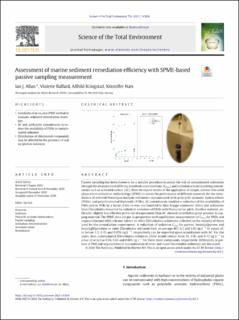Assessment of marine sediment remediation efficiency with SPME-based passive sampling measurement
Peer reviewed, Journal article
Published version
Permanent lenke
https://hdl.handle.net/11250/2764618Utgivelsesdato
2021Metadata
Vis full innførselSamlinger
- Publikasjoner fra Cristin - NIVA [2160]
- Scientific publications [1172]
Originalversjon
Science of the Total Environment. 2021, 756, 143854. 10.1016/j.scitotenv.2020.143854Sammendrag
Passive sampling has been shown to be a suitable procedure to assess the risk of contaminated sediments through the measurement of freely dissolved concentrations (CFree) and remedial actions involving amendments such as activated carbon (AC). Here we report results of the application of simple, solvent-free solid phase micro extraction methodology (SPME) to assess the performance of different materials for the remediation of selected Norwegian harbour sediments contaminated with polycyclic aromatic hydrocarbons (PAHs) and polychlorinated biphenyls (PCBs). AC amendments enabled a reduction of the availability of PAHs and/or PCBs by a factor of ten to over one hundred in Aker Brygge sediments (Oslo) and sediments from Elkembukta, impacted by industrial emissions of PAHs with/from coal tar pitch. Another material, anthracite, slightly less effective in this set of experiment than AC, showed nonetheless great promise as capping material. The SPME data are put in perspective with equilibrium measurements of CFree for PAHs and organochlorines with silicone rubber in other Elkembukta sediments collected in the vicinity of those used for the remediation experiments. A reduction of sediment Cfree for pyrene, benzo[a]pyrene and benzo[ghi]perylene in inner Elkembukta sediment from on average 407, 6.3 and 0.82 ng L−1 to values of/or below 1.3, 0.15 and 0.076 ng L−1, respectively can be expected upon remediation with AC. For the outer, less contaminated Elkembukta sediment, Cfree would reduce from 36, 0.81 and 0.13 ng L−1 to value of or below 0.06, 0.03 and 0.005 ng L−1 for these three compounds, respectively. Differences in pattern of PAH and organochlorine contamination of inner and outer Elkembukta sediments are discussed.

